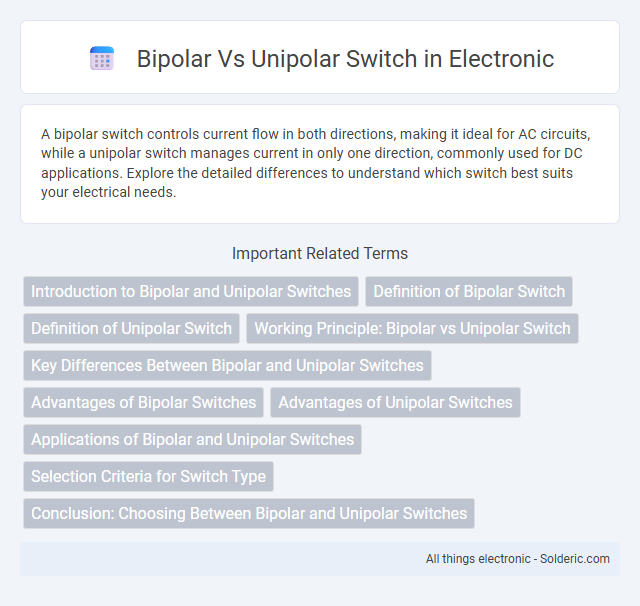A bipolar switch controls current flow in both directions, making it ideal for AC circuits, while a unipolar switch manages current in only one direction, commonly used for DC applications. Explore the detailed differences to understand which switch best suits your electrical needs.
Comparison Table
| Feature | Bipolar Switch | Unipolar Switch |
|---|---|---|
| Definition | Switch that controls current flow in both positive and negative directions | Switch that controls current flow in one direction only |
| Poles | Two poles or more | Single pole |
| Contact Configuration | Double throw or multiple throws | Single throw or simple ON/OFF |
| Applications | Used in AC circuits and bidirectional control | Used in DC circuits and unidirectional control |
| Complexity | More complex, handles higher power | Simpler, handles lower power |
| Cost | Generally higher due to complexity | Lower cost |
| Example | Bipolar junction transistor switch | Single pole single throw (SPST) switch |
Introduction to Bipolar and Unipolar Switches
Bipolar switches operate by controlling current flow through both positive and negative semiconductor layers, enabling efficient management of high voltage and current in applications like power regulation and audio amplification. Unipolar switches rely on a single type of charge carrier, typically electrons, allowing faster switching speeds and lower noise, making them ideal for digital circuits and low-power applications. The fundamental difference lies in their construction and operational mechanisms, which directly influence their performance characteristics and suitability across various electronic devices.
Definition of Bipolar Switch
A bipolar switch is an electronic component that can control current flow in both directions, typically using bipolar junction transistors (BJTs) or similar semiconductor devices. Unlike unipolar switches, which operate by controlling one type of charge carrier, bipolar switches manage both electron and hole currents to enable bidirectional switching capabilities. This property makes bipolar switches essential in applications requiring precise current regulation, such as in power electronics and motor control systems.
Definition of Unipolar Switch
A unipolar switch is an electronic component that controls the flow of current using a single type of charge carrier, either electrons or holes. Unlike bipolar switches, which rely on both charge carriers for operation, unipolar switches typically offer faster switching speeds and lower power consumption. These switches are commonly found in field-effect transistors (FETs) used for digital and analog circuit applications.
Working Principle: Bipolar vs Unipolar Switch
Bipolar switches control current flow in both directions by using two complementary transistors, allowing more precise and efficient switching in AC and DC applications. Unipolar switches operate with a single type of charge carrier, controlling current in only one direction, which simplifies circuit design but limits their use to DC applications. Your choice between bipolar and unipolar switches should consider the required control over current direction and application type to optimize performance.
Key Differences Between Bipolar and Unipolar Switches
Bipolar switches control current flow in both directions by using two terminals to manage positive and negative voltages, making them ideal for AC applications and devices requiring bidirectional control. Unipolar switches, with a single terminal, regulate current in one direction, optimizing performance for DC circuits and simpler electronic devices. Understanding these key differences helps you select the appropriate switch for your specific electrical or electronic project needs.
Advantages of Bipolar Switches
Bipolar switches offer superior current handling capabilities compared to unipolar switches, enabling efficient control of both positive and negative voltage cycles in AC circuits. Their ability to reduce electromagnetic interference and provide faster switching speeds enhances overall circuit performance and reliability. These advantages make bipolar switches ideal for complex power regulation and high-frequency applications.
Advantages of Unipolar Switches
Unipolar switches offer simplified control and faster switching speeds due to having a single type of charge carrier, either electrons or holes, which reduces complexity in circuit design. They typically consume less power and generate less heat compared to bipolar switches, enhancing energy efficiency and device longevity. The unipolar architecture also provides higher switching frequency capabilities, making them ideal for high-speed digital and RF applications.
Applications of Bipolar and Unipolar Switches
Bipolar switches, commonly used in power electronics and motor control applications, provide high current handling and fast switching capabilities essential for efficient energy management in industrial machinery and electric vehicles. Unipolar switches are preferred in digital circuits and low-power applications such as microprocessors and memory devices due to their simple structure and lower power consumption. Both bipolar and unipolar switches play crucial roles in optimizing performance and efficiency across a wide range of electronic and electrical systems.
Selection Criteria for Switch Type
Selection criteria for bipolar versus unipolar switches depend primarily on the application's voltage and current requirements, switching speed, and power dissipation. Bipolar switches, such as BJTs, offer higher current gain and are preferred for linear amplification and high-current applications, while unipolar switches like MOSFETs provide faster switching speeds and greater efficiency at lower gate-drive power. Thermal performance and switching frequency also influence the choice, with MOSFETs favored in high-frequency circuits due to their lower gate charge and reduced switching losses.
Conclusion: Choosing Between Bipolar and Unipolar Switches
Choosing between bipolar and unipolar switches depends on the specific application requirements and performance criteria. Bipolar switches offer higher current capacity and better linearity, making them ideal for high-power and precision analog circuits. Unipolar switches consume less power and have simpler control mechanisms, which suits low-power and digital switching uses.
bipolar vs unipolar switch Infographic

 solderic.com
solderic.com